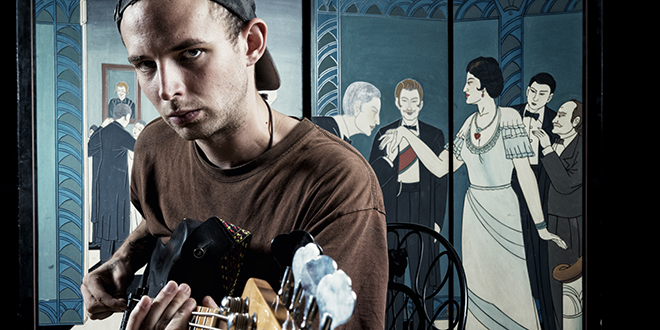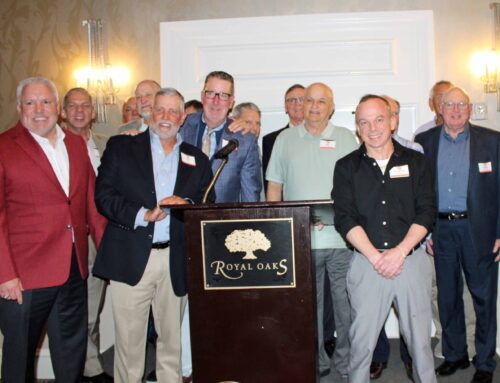I met Zerp when I was writing a story about a talented young performer named Kameron Badgers. While seeking out Kameron among hundreds of summer circus campers in a North Dallas gymnasium, I couldn’t help but notice this guy with a yellow afro. He was balancing a plunger on his nose.
When we tracked down Kameron, he let us know that he was learning a new trick — knife juggling — from a master.
“This is Zerp,” Kameron said, admiringly. Zerp put his plunger away, offered a quick greeting then dug into his wooden chest removing three large knives, machetes, essentially.
Kameron juggled those things with little problems. Zerp explained that they were real knives, but not sharp enough to cut your arm off or anything.
Later that day, Fred Holland told me a little more about Zerp the clown who was working his son Kameron—the clown’s real name was Nic Rainone, he came from a lineage of clowns and performers, his parents were famous clowns with a TV show, he traveled with Ringling Bros. He was known as one of the best. And Kameron obviously adored him.
When I learned that Rainone grew up in Lake Highlands, I knew I wanted to write about him.
A year later, 22-year-old Nic Rainone is profiled in our August issue.
(Read: The Complexities of Clown Life)
I learned some things from Nic. For example, being a clown is an art form. Clowns are artists. Great artists tend to be sensitive and thus susceptible to angst. Being a clown is in Nic’s blood, but he struggles with wanting to be more than just a clown. His hair is no longer bushy yellow, but short and dark.
When one of my co-editors read the spotlight on Nic, she pointed me to a long-form story about a troubled clown by the well-loved, Pulitizer-winning nonfiction writer Gene Weingarten. She thought there were some parallels, and there were. The Great Zucchini, a DC- based clown to the rich and famous, was struggling with some personal demons. The Zucchini story, about the real Eric Knaus, is titled “The Peek-a-boo Paradox” and ran years ago in the Washington Post and later in a collection, “The Fiddler on the Subway.”
It is a breathtaking piece of storytelling, whose depths I can only aspire to reach, and recommended reading for everyone.
At first I thought it would be a think piece about the silly things on which rich people in suburbia spend money ($300 a pop for a clown who doesn’t even wear a costume), but it was not. It rather was a meditation on a complex man who was incredibly successful, profound, gifted and, yes, Great, in one area of his life while the rest of it was as tattered as his worn-out bag of tricks (literally, the bag in which he carried his props was described as dirty, stained, old and gross).
Also, by brilliantly weaving himself into the story, Weingarten addresses questions we ask ourselves with each piece we propose here — why are you writing about him? And, do people care?
Check out this scene where one of the mothers at a party asks Weingarten why Zucchini is newsworthy.
“You’re writing a story about him?” Vicki Cox asked, amused. I confirmed that I was.
“But . . . why?” she asked.
A few feet away, the Great Zucchini was pretending to be afraid of his own hand.
“I mean,” Vicki said, “what’s the hook?”
Now, the Great Zucchini was eating toilet paper.
“I mean, are you that desperate?” she asked.
Weingarten goes on to describe the magical powers Zucchini holds over children and the success he has found, pulling in some $100,000 a year working two days a week. How he sets himself apart from the other entertainers in the industry. Weingarten continues:
“There are dozens of professional children’s entertainers in the Washington area, but only one is as successful and intriguing, and as completely over-the-top preposterous, as the Great Zucchini. And if you want to know why that is — the hook, Vicki, the hook — it’s going to take some time.”
As the story progresses, one senses Weingarten’s purpose, and begins to understand the story’s value, as the writer cozies up to a local personality and tells us his secrets, which are not nice, or neat or happy. The author expertly unpeels his subject, slowly revealing the flaws, the complexities and ambiguities of this person who, at face value, is an enviable success. Weingarten does so with great sensitivity, leaving us loving Zucchini despite his problems, and possibly even more for them.
At the Advocate we are always asking ourselves how the stories we write benefit the reader, the people who live in the neighborhood who receive and read the magazine. (Note: we have four magazines, a different one for each of four Dallas neighborhoods, each with articles tailored to its neighborhood, and much thought goes into each component of every magazine.)
For us, it is easy to see why a story with information about, say, a construction project, a crime reduction effort or a new restaurant or other business is useful to our readers — these articles and sections offer practical, handy, easily digestible information that can be applied to daily decision making.
But what makes a person worth writing about? How does writing about a person serve the reader? That is always a tough one to answer.
But here is how I look at it:
Anyone who reads a story by Gene Weingarten emerges with a deeper understanding of his fellow man. Thus, he or she, at least temporarily, is kinder and more accepting of his or her neighbor. Weingarten’s work leaves readers worldwide feeling a little more enamored with life and its complexities, a little more willing to wait and see a person’s layers — to hear his side of the story — before casting judgment.
And that is the hook. That is the service. Publications such as the Post or Texas Monthly or The New Yorker offer this service on a grand scale. For us, though on a narrower scale, that is the goal when we write about people like Kameron or Nic.
In an era where so many people craft via Facebook and Instagram the life they want the world to see — carefully concealing every wrinkle, every mistake, every shortcoming — it is a gift when a person is forthcoming about his real existence.
When we write about these amazing neighborhood people, we are shooting for that deeper understanding of each other — so when you see a heavily tattooed twenty-something with bushy yellow hair approaching, you will not cross the street and avert your eyes. You might instead smile and say Hello and wonder if he’s that fellow you read about in the Advocate — the artist.






